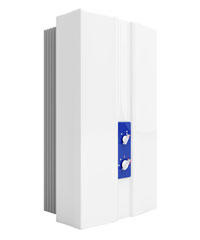If your tankless water heater freezes, it may be subjected to severe internal damage and leakage, which can affect heating efficiency. What’s worse, the cost of repairing or replacing it probably won’t be covered by your warranty. Most manufacturer warranties require homeowners to take appropriate winterizing steps to ensure their heaters don't freeze when it’s not in use for an extended period of time.
While most indoor and outdoor units incorporate a freeze protection function for short-term dips in temperature, this option probably won’t protect your tankless water heater from long exposures to more acute temperatures, especially during periods when you may be away from your home for several days.
This is why homeowners who live in areas where winter temperatures drop into the freeze zone should have a qualified plumber winterize their tankless heater during periods of non-use. Here’s what should be done:
If your heater has been operating in the last hour, let your unit cool down, so it can be handled.
Your heater should be disconnected from the electrical outlet or electricity should be shut off at the breaker.
The gas supply should be shut off at the valve on the gas line.
Water supply to the heater should be turned off at the inline shut off valve.
Faucets located near your heater should be opened to bleed off pressure inside the plumbing.
Both the cold water inlet and hot water outlet pipes should be disconnected from the heater before the inlet water filter is removed.
Residual water inside your heater and pipes should be drained out into a bucket. Your plumber may utilize an air compressor to blow the pipes clear of all remaining water.
For long periods of disuse, both the intake and exhaust vents should be capped to prevent accumulation of leaves and other debris.
To protect against freezing weather during severe cold spells in Broken Arrow, contact a qualified plumbing professional at Air Assurance.
Our goal is to help educate our customers in the Tulsa and Broken Arrow, Oklahoma area about energy and home comfort issues (specific to HVAC systems). Credit/Copyright Attribution: “Mile Atanasov/Shutterstock”


